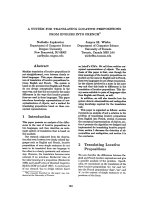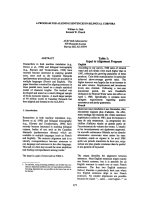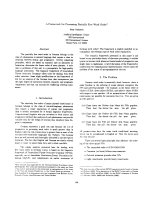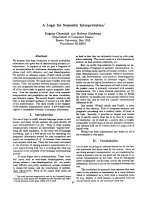Báo cáo khoa học: "A System for Detecting Subgroups in Online Discussions" pptx
Bạn đang xem bản rút gọn của tài liệu. Xem và tải ngay bản đầy đủ của tài liệu tại đây (429.8 KB, 6 trang )
Proceedings of the 50th Annual Meeting of the Association for Computational Linguistics, pages 133–138,
Jeju, Republic of Korea, 8-14 July 2012.
c
2012 Association for Computational Linguistics
Subgroup Detector: A System for Detecting Subgroups in Online
Discussions
Amjad Abu-Jbara
EECS Department
University of Michigan
Ann Arbor, MI, USA
Dragomir Radev
EECS Department
University of Michigan
Ann Arbor, MI, USA
Abstract
We present Subgroup Detector, a system
for analyzing threaded discussions and
identifying the attitude of discussants towards
one another and towards the discussion
topic. The system uses attitude predictions to
detect the split of discussants into subgroups
of opposing views. The system uses an
unsupervised approach based on rule-based
opinion target detecting and unsupervised
clustering techniques. The system is open
source and is freely available for download.
An online demo of the system is available at:
/>1 Introduction
Online forums discussing ideological and political
topics are common
1
. When people discuss a con-
troversial topic, it is normal to see situations of both
agreement and disagreement among the discussants.
It is even not uncommon that the big group of dis-
cussants split into two or more smaller subgroups.
The members of each subgroup have the same opin-
ion toward the discission topic. The member of a
subgroup is more likely to show positive attitude to
the members of the same subgroup, and negative at-
titude to the members of opposing subgroups. For
example, consider the following snippet taken from
a debate about school uniform
1
www.politicalforum.com, www.createdebate.com,
www.forandagainst.com, etc
(1) Discussant 1: I believe that school uniform is a
good idea because it improves student attendance.
(2) Discussant 2: I disagree with you. School uniform
is a bad idea because people cannot show their person-
ality.
In (1), the writer is expressing positive attitude
regarding school uniform. The writer of (2) is ex-
pressing negative attitude (disagreement) towards
the writer of (1) and negative attitude with respect
to the idea of school uniform. It is clear from this
short dialog that the writer of (1) and the writer of
(2) are members of two opposing subgroups. Dis-
cussant 1 supports school uniform, while Discussant
2 is against it.
In this demo, we present an unsupervised system
for determining the subgroup membership of each
participant in a discussion. We use linguistic tech-
niques to identify attitude expressions, their polar-
ities, and their targets. We use sentiment analy-
sis techniques to identify opinion expressions. We
use named entity recognition, noun phrase chunk-
ing and coreference resolution to identify opinion
targets. Opinion targets could be other discussants
or subtopics of the discussion topic. Opinion-target
pairs are identified using a number of hand-crafted
rules. The functionality of this system is based on
our previous work on attitude mining and subgroup
detection in online discussions.
This work is related to previous work in the areas
of sentiment analysis and online discussion mining.
Many previous systems studied the problem of iden-
133
tifying the polarity of individual words (Hatzivas-
siloglou and McKeown, 1997; Turney and Littman,
2003). Opinionfinder (Wilson et al., 2005) is a sys-
tem for mining opinions from text. SENTIWORD-
NET (Esuli and Sebastiani, 2006) is a lexical re-
source in which each WordNet synset is associated
to three numerical scores Obj(s), Pos(s) and Neg(s),
describing how objective, positive, and negative the
terms contained in the synset are. Dr Sentiment (Das
and Bandyopadhyay, 2011) is an online interactive
gaming technology used to crowd source human
knowledge to build an extension of SentiWordNet.
Another research line focused on analyzing on-
line discussions. For example, Lin et al. (2009)
proposed a sparse coding-based model that simul-
taneously models the semantics and the structure
of threaded discussions. Shen et al. (2006) pro-
posed a method for exploiting the temporal and lex-
ical similarity information in discussion streams to
identify the reply structure of the dialog. Many sys-
tems addressed the problem of extracting social net-
works from discussions (Elson et al., 2010; McCal-
lum et al., 2007). Other related sentiment analy-
sis systems include MemeTube (Li et al., 2011), a
sentiment-based system for analyzing and display-
ing microblog messages; and C-Feel-It (Joshi et al.,
2011), a sentiment analyzer for micro-blogs.
In the rest of this paper, we describe the system
architecture, implementation, usage, and its evalua-
tion.
2 System Overview
Figure 1 shows a block diagram of the system com-
ponents and the processing pipeline. The first com-
ponent is the thread parsing component which takes
as input a discussion thread and parses it to iden-
tify posts, participants, and the reply structure of the
thread. The second component in the pipeline pro-
cesses the text of posts to identify polarized words
and tag them with their polarity. The list of polar-
ity words that we use in this component has been
taken from the OpinionFinder system (Wilson et al.,
2005).
The polarity of a word is usually affected by the
context in which it appears. For example, the word
fine is positive when used as an adjective and neg-
ative when used as a noun. For another example, a
positive word that appears in a negated context be-
comes negative. To address this, we take the part-
of-speech (POS) tag of the word into consideration
when we assign word polarities. We require that the
POS tag of a word matches the POS tag provided in
the list of polarized words that we use. The negation
issue is handled in the opinion-target pairing step as
we will explain later.
The next step in the pipeline is to identify the can-
didate targets of opinion in the discussion. The tar-
get of attitude could be another discussant, an entity
mentioned in the discussion, or an aspect of the dis-
cussion topic. When the target of opinion is another
discussant, either the discussant name is mentioned
explicitly or a second person pronoun (e.g you, your,
yourself) is used to indicate that the opinion is tar-
geting the recipient of the post.
The target of opinion could also be a subtopic or
an entity mentioned in the discussion. We use two
methods to identify such targets. The first method
depends on identifying noun groups (NG). We con-
sider as an entity any noun group that is mentioned
by at least two different discussants. We only con-
sider as entities noun groups that contain two words
or more. We impose this requirement because in-
dividual nouns are very common and considering
all of them as candidate targets will introduce sig-
nificant noise. In addition to this shallow pars-
ing method, we also use named entity recognition
(NER) to identify more targets. The named en-
tity tool that we use recognizes three types of en-
tities: person, location, and organization. We im-
pose no restrictions on the entities identified using
this method.
A challenge that always arises when perform-
ing text mining tasks at this level of granularity
is that entities are usually expressed by anaphori-
cal pronouns. Jakob and Gurevych (2010) showed
experimentally that resolving the anaphoric links
134
Discussion
Thread
….…….
….…….
….…….
Opinion Identification
• Identify polarized words
• Identify the contextual
polarity of each word
Target Identification
• Anaphora resolution
• Identify named entities
• Identify Frequent noun
phrases.
• Identify mentions of
other discussants
Opinion-Target Pairing
• Dependency Rules
Discussant Attitude
Profiles (DAPs)
Clustering
Subgroups
Thread Parsing
• Identify posts
• Identify discussants
• Identify the reply
structure
• Tokenize text.
• Split posts into sentences
Figure 1: A block diagram illustrating the processing pipeline of the subgroup detection system
in text significantly improves opinion target extrac-
tion. Therefore, we use co-reference resolution tech-
niques to resolve all the anaphoric links in the dis-
cussion thread.
At this point, we have all the opinion words and
the potential targets identified separately. The next
step is to determine which opinion word is target-
ing which target. We propose a rule based approach
for opinion-target pairing. Our rules are based on
the dependency relations that connect the words in
a sentence. An opinion word and a target form a
pair if the dependency path between them satisfies
at least one of our dependency rules. Table 1 illus-
trates some of these rules. The rules basically exam-
ine the types of dependency relations on the shortest
path that connect the opinion word and the target in
the dependency parse tree. It has been shown in pre-
vious work on relation extraction that the shortest
dependency path between any two entities captures
the information required to assert a relationship be-
tween them (Bunescu and Mooney, 2005). If a sen-
tence S in a post written by participant P
i
contains
an opinion word OP
j
and a target T R
k
, and if the
opinion-target pair satisfies one of our dependency
rules, we say that P
i
expresses an attitude towards
T R
k
. The polarity of the attitude is determined by
the polarity of OP
j
. We represent this as P
i
+
→ T R
k
if OP
j
is positive and P
i
−
→ T R
k
if OP
j
is nega-
tive. Negation is handled in this step by reversing
the polarity if the polarized expression is part of a
neg dependency relation.
It is likely that the same participant P
i
expresses
sentiment towards the same target T R
k
multiple
times in different sentences in different posts. We
keep track of the counts of all the instances of posi-
tive/negative attitude P
i
expresses toward T R
k
. We
represent this as P
i
m+
−−→
n−
T R
k
where m (n) is the
number of times P
i
expressed positive (negative) at-
titude toward T R
k
.
Now, we have information about each discussant
attitude. We propose a representation of discus-
sants
´
attitudes towards the identified targets in the
discussion thread. As stated above, a target could
be another discussant or an entity mentioned in the
discussion. Our representation is a vector contain-
ing numerical values. The values correspond to the
counts of positive/negative attitudes expressed by
the discussant toward each of the targets. We call
this vector the discussant attitude profile (DAP). We
construct a DAP for every discussant. Given a dis-
cussion thread with d discussants and e entity tar-
gets, each attitude profile vector has n = (d + e) ∗ 3
dimensions. In other words, each target (discussant
or entity) has three corresponding values in the DAP:
1) the number of times the discussant expressed pos-
itive attitude toward the target, 2) the number of
times the discussant expressed a negative attitude to-
wards the target, and 3) the number of times the the
discussant interacted with or mentioned the target.
It has to be noted that these values are not symmet-
135
ID Rule In Words
R1 OP → nsubj → T R The target TR is the nominal subject of the opinion word OP
R2 OP → dobj → T R The target T is a direct object of the opinion OP
R3 OP → prep ∗ → T R The target TR is the object of a preposition that modifies the opinion word OP
R4 TR → amod → OP The opinion is an adjectival modifier of the target
R5 OP → nsubjpass → T R The target TR is the nominal subject of the passive opinion word OP
R6 OP → prep ∗ → poss → T R The opinion word OP connected through a prep ∗ relation as in R2 to something pos-
sessed by the target TR
R7 OP → dobj → poss → T R The target TR possesses something that is the direct object of the opinion word OP
R8 OP → csubj → nsubj → T R The opinon word OP is a causal subject of a phrase that has the target TR as its nominal
subject.
Table 1: Examples of the dependency rules used for opinion-target pairing.
ric since the discussions explicitly denote the source
and the target of each post.
At this point, we have an attitude profile (or vec-
tor) constructed for each discussant. Our goal is to
use these attitude profiles to determine the subgroup
membership of each discussant. We can achieve this
goal by noticing that the attitude profiles of discus-
sants who share the same opinion are more likely to
be similar to each other than to the attitude profiles
of discussants with opposing opinions. This sug-
gests that clustering the attitude vector space will
achieve the goal and split the discussants into sub-
groups based on their opinion.
3 Implementation
The system is fully implemented in Java. Part-of-
speech tagging, noun group identification, named
entity recognition, co-reference resolution, and de-
pendency parsing are all computed using the Stan-
ford Core NLP API.
2
The clustering component
uses the JavaML library
3
which provides implemen-
tations to several clustering algorithms such as k-
means, EM, FarthestFirst, and OPTICS.
The system requires no installation. It, however,
requires that the Java Runtime Environment (JRE)
be installed. All the dependencies of the system
come bundled with the system in the same package.
The system works on all the standard platforms.
The system has a command-line interface that
2
/>3
/>provides full access to the system functionality. It
can be used to run the whole pipeline to detect sub-
groups or any portion of the pipeline. For example,
it can be used to tag an input text with polarity or to
identify candidate targets of opinion in a given in-
put. The system behavior can be controlled by pass-
ing arguments through the command line interface.
For example, the user can specify which clustering
algorithm should be used.
To facilitate using the system for research pur-
poses, the system comes with a clustering evaluation
component that uses the ClusterEvaluator package.
4
.
If the input to the system contains subgroup labels,
it can be run in the evaluation mode in which case
the system will output the scores of several different
clustering evaluation metrics such as purity, entropy,
f-measure, Jaccard, and RandIndex. The system also
has a Java API that can be used by researchers to de-
velop other systems using our code.
The system can process any discussion thread that
is input to it in a specific format. The format of
the input and output is described in the accompa-
nying documentation. It is the user responsibility
to write a parser that converts an online discussion
thread to the expected format. However, the sys-
tem package comes with two such parsers for two
different discussion sites: www.politicalforum.com
and www.createdebate.com.
The distribution also comes with three datasets
4
/>measure/javadoc/index.html
136
Figure 2: A screenshot of the online demo
(from three different sources) comprising a total of
300 discussion threads. The datasets are annotated
with the subgroup labels of discussants.
Finally, we created a web interface to demonstrate
the system functionality. The web interface is in-
tended for demonstration purposes only. No web-
service is provided. Figure 2 shows a screenshots of
the web interface. The online demo can be accessed
at />4 Evaluation
In this section, we give a brief summary of the sys-
tem evaluation. We evaluated the system on discus-
sions comprising more than 10,000 posts in more
than 300 different topics. Our experiments show that
the system detects subgroups with promising accu-
racy. The average clustering purity of the detected
subgroups in the dataset is 0.65. The system signif-
icantly outperforms baseline systems based on text
clustering and discussant interaction frequency. Our
experiments also show that all the components in the
system (such as co-reference resolution, noun phrase
chunking, etc) contribute positively to the accuracy.
5 Conclusion
We presented a demonstration of a discussion min-
ing system that uses linguistic analysis techniques to
predict the attitude the participants in online discus-
sions forums towards one another and towards the
different aspects of the discussion topic. The system
is capable of analyzing the text exchanged in dis-
cussions and identifying positive and negative atti-
tudes towards different targets. Attitude predictions
are used to assign a subgroup membership to each
participant using clustering techniques. The sys-
tem predicts attitudes and identifies subgroups with
promising accuracy.
References
Razvan Bunescu and Raymond Mooney. 2005. A short-
est path dependency kernel for relation extraction. In
Proceedings of Human Language Technology Confer-
ence and Conference on Empirical Methods in Nat-
ural Language Processing, pages 724–731, Vancou-
ver, British Columbia, Canada, October. Association
for Computational Linguistics.
Amitava Das and Sivaji Bandyopadhyay. 2011. Dr sen-
timent knows everything! In Proceedings of the ACL-
HLT 2011 System Demonstrations, pages 50–55, Port-
land, Oregon, June. Association for Computational
Linguistics.
137
David Elson, Nicholas Dames, and Kathleen McKeown.
2010. Extracting social networks from literary fiction.
In Proceedings of the 48th Annual Meeting of the Asso-
ciation for Computational Linguistics, pages 138–147,
Uppsala, Sweden, July.
Andrea Esuli and Fabrizio Sebastiani. 2006. Sentiword-
net: A publicly available lexical resource for opinion
mining. In In Proceedings of the 5th Conference on
Language Resources and Evaluation (LREC06, pages
417–422.
Vasileios Hatzivassiloglou and Kathleen R. McKeown.
1997. Predicting the semantic orientation of adjec-
tives. In EACL’97, pages 174–181.
Niklas Jakob and Iryna Gurevych. 2010. Using anaphora
resolution to improve opinion target identification in
movie reviews. In Proceedings of the ACL 2010 Con-
ference Short Papers, pages 263–268, Uppsala, Swe-
den, July. Association for Computational Linguistics.
Aditya Joshi, Balamurali AR, Pushpak Bhattacharyya,
and Rajat Mohanty. 2011. C-feel-it: A sentiment ana-
lyzer for micro-blogs. In Proceedings of the ACL-HLT
2011 System Demonstrations, pages 127–132, Port-
land, Oregon, June. Association for Computational
Linguistics.
Cheng-Te Li, Chien-Yuan Wang, Chien-Lin Tseng, and
Shou-De Lin. 2011. Memetube: A sentiment-based
audiovisual system for analyzing and displaying mi-
croblog messages. In Proceedings of the ACL-HLT
2011 System Demonstrations, pages 32–37, Portland,
Oregon, June. Association for Computational Linguis-
tics.
Chen Lin, Jiang-Ming Yang, Rui Cai, Xin-Jing Wang,
and Wei Wang. 2009. Simultaneously modeling se-
mantics and structure of threaded discussions: a sparse
coding approach and its applications. In SIGIR ’09,
pages 131–138.
Andrew McCallum, Xuerui Wang, and Andr
´
es Corrada-
Emmanuel. 2007. Topic and role discovery in so-
cial networks with experiments on enron and academic
email. J. Artif. Int. Res., 30:249–272, October.
Dou Shen, Qiang Yang, Jian-Tao Sun, and Zheng Chen.
2006. Thread detection in dynamic text message
streams. In SIGIR ’06, pages 35–42.
Peter Turney and Michael Littman. 2003. Measuring
praise and criticism: Inference of semantic orientation
from association. ACM Transactions on Information
Systems, 21:315–346.
Theresa Wilson, Paul Hoffmann, Swapna Somasun-
daran, Jason Kessler, Janyce Wiebe, Yejin Choi, Claire
Cardie, Ellen Riloff, and Siddharth Patwardhan. 2005.
Opinionfinder: a system for subjectivity analysis. In
HLT/EMNLP - Demo.
138









